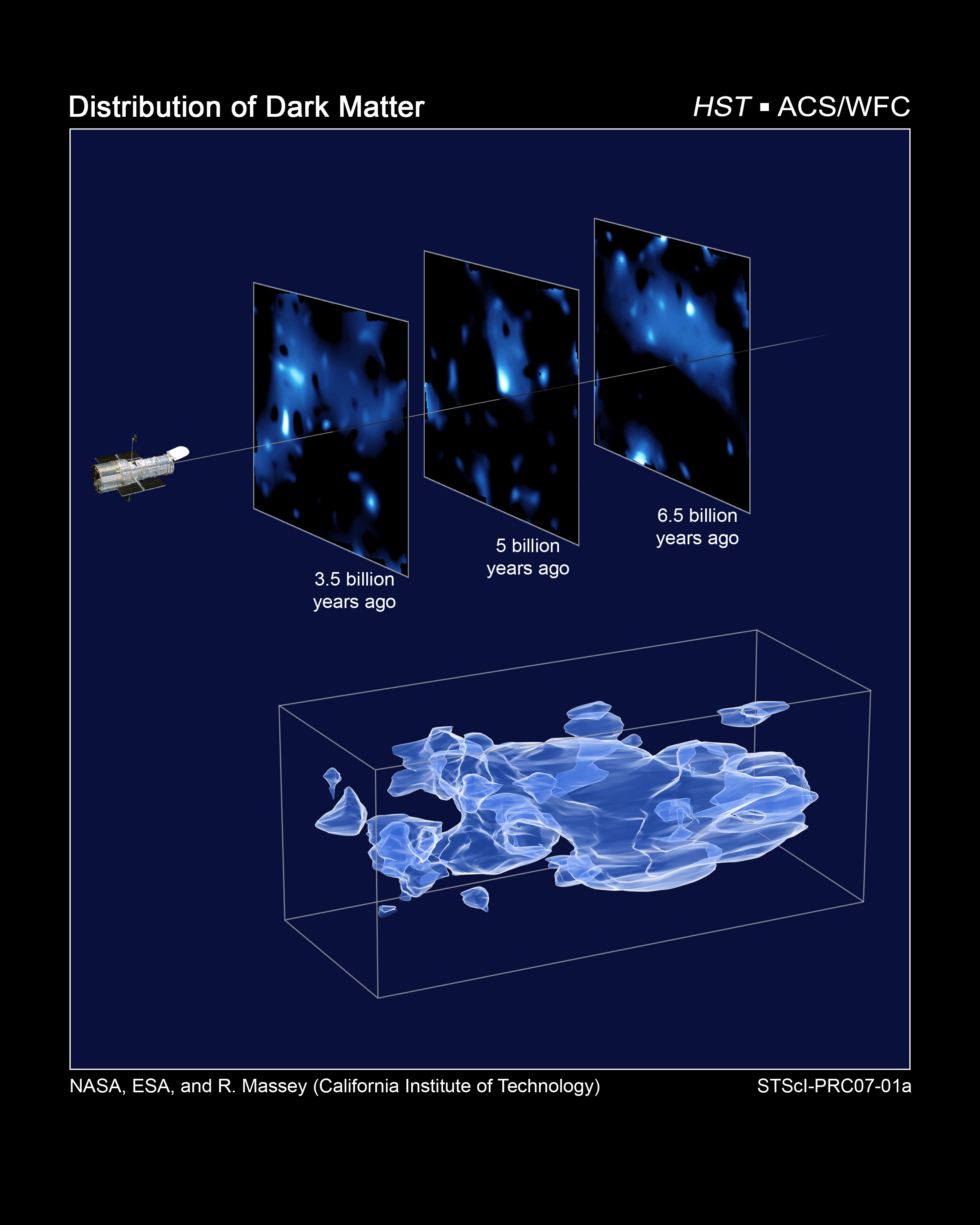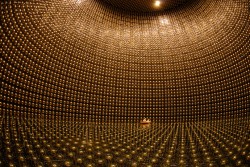How do you catch a WIMP? No, I’m not talking about bullying the weakest kid in class, I’m talking about Weakly Interacting Massive Particles (those WIMPs). Well, it isn’t easy. Although they are “massive” by definition, they do not interact with the electromagnetic force (via photons) so they cannot be “seen” and they do not interact with the strong nuclear force, so they cannot be “felt” by atomic nuclei. If we cannot detect WIMPs via these two forces, how can we possibly ever hope to detect them? After all, WIMPs are theorized to be flying through the Earth without hitting anything, they are that weakly interacting. But sometimes, they might collide with atomic nuclei but only if they collide head-on. This is a very rare occurrence, but the Large Underground Xenon (LUX) detector will be buried 4,800 feet (1,463 meters, or nearly a mile) underground in an old South Dakota goldmine and scientists are hopeful that when an unlucky WIMP bumps into a xenon atom, a flash of light will be captured, signifying the first ever experimental evidence of dark matter…
Galaxies observed from Earth have some strange qualities. The biggest problem for cosmologists has been to explain why galaxies (including the Milky Way) appear to have more mass than can be observed by counting stars and accounting for interstellar dust alone. In fact, 96% of the Universe’s mass cannot be observed. 22% of this missing mass is thought to be held in “dark matter” (74% is held as “dark energy”). Dark matter is theorized to take on many forms. Massive Astronomical Compact Halo Objects (astronomical bodies containing ordinary baryonic material that cannot be observed; like neutron stars or orphaned planets), neutrinos and WIMPS all are thought to contribute toward this missing mass. Many experiments are in progress to detect each contributor. Black holes can be indirectly detected by observing the interactions in the centre of galaxies (or gravitational lensing effects), neutrinos can be detected in huge tanks of fluid buried deep underground, but how can WIMPs be detected? It seems a WIMP detector needs to take a leaf out of the neutrino detector’s books – it needs to start digging.
To avoid interference from radiation such as cosmic rays, low energy detectors such as neutrino “telescopes” are buried well below the Earth’s surface. Old mine shafts make ideal candidates as the hole is already there for the instrumentation to be set up. Neutrino detectors are huge containers of water (or some other agent) with highly sensitive detectors positioned around the outside. One such example is the Super Kamiokande neutrino detector in Japan which contains a vast amount of ultra-purified water, weighing in at 50,000 tons (pictured left). As a weakly interacting neutrino hits a water molecule in the tank, a flash of Cherenkov radiation is emitted and a neutrino is detected. This is the basic principal behind the new Large Underground Xenon (LUX) detector that will use 600 pounds (272 kg) of liquid xenon suspended in a 25 foot high tank of pure water. If WIMPs exist beyond the realms of theory, it is hoped that these weakly interacting massive particles will collide head-on with a xenon atom, and like their light-weight cousins, emit a flash of light.
Robert Svoboda and Mani Tripathi, UC Davis professors, have secured $1.2 million in National Science Foundation (NSF) and U.S. Department of Energy funding for the project (this is 50% of the total required). When compared with the Large Hadron Collider (LHC) costing billions of Euros to build, LUX is a highly economic project considering the scope of what it might discover. Should there be experimental evidence of a WIMP interaction, the consequences will be enormous. We will be able to begin to understand the origins of WIMPs and their distribution as the Earth sweeps through the possible dark matter halo that is indirectly observed to exist in the Milky Way.
Detecting dark matter “would be the biggest deal since finding antimatter in the 1930s.” – Professor Mani Tripathi, LUX co-investigator, UC Davis.
The gold mine in South Dakota was closed in 2000 and in 2004 work began to develop the site into an underground laboratory. LUX will be the first large experiment to be housed there. It is hoped that the installation will start late summer, after water has been pumped out of the mine.
Original source: UC Davis News



Its a pic of technicians in the Super Kamiokande neutrino detector in Japan (as mentioned in the text).
Have a look here: http://en.wikipedia.org/wiki/Super-Kamiokande
Hope that helps 🙂 Ian
Posted this link in http://www.surfurls.com
What the hell is that picture of, it looks like two people inside. Is it a giant room with gold mirrors or what? Can someone please explain to me what I am looking at?
# Ry Says:
May 5th, 2008 at 7:36 pm
“What the hell is that picture of, it looks like two people inside. Is it a giant room with gold mirrors or what? Can someone please explain to me what I am looking at?”
Ain’t it cool? I love scientific instruments such as Super-K and those at the LHC not only for the amazing science, but the fact that they just look science-fictiony and awesome.
On topic – 2.4 million is bargain basement for an experiment like this. I wish I were rich – I’d fund these sorts of things myself. Good luck to ’em!
By the way, anyone who is fascinated by all of the talk in some UT articles (incl. this one) of the Weak force, the Strong force, the EM force and whatnot would do well to buy and read Bruce A. Schumm’s ‘Deep Down Things: The Breathtaking Beauty of Particle Physics’.
If you are not a physicist or a mathematician, but have a keen and inquiring mind then it is a book that won’t disappoint. It rises far above the level of mere pop-science, elucidating some of the most wonderful and beautiful aspects of the Standard Model of particle physics in an amazingly clear and readable way.
There’s even a lot in there for actual physicists – It’s a great ‘big picture’ book for getting your thoughts on the subject organised before diving into the mathematical minutiae. Check it out.
BTW – I’m not associated with the book or author in any way shape or form, other than thinking it was a great read.
This is an experiment based on one single hypothesis: WIMP’s. Suppose MACHO’s were the answer, then it is a waste of money.
The LHC is not a single hypothesis tool.
Ian, you write “Dark matter is theorized to take on many forms.” Would it not be better to use “Hypothesized” even if it sounds clumsy, because to me the “Theory of WIMPS” does not carry the same level of credibility as say: the “Theory of Evolution”
Hi Ignoramus:
Well, dark matter theory is a theory. There is experimental evidence that shows that there is some extra mass out there. The theory is that this matter is made up of the very big (i.e. black holes) and the very small (WIMPs, neutrinos etc). It’s not really a hypothesis as there is indirect experimental evidence that these forms of dark matter DO exist (I gave one example from the galactic halos), so it’s all about planning how to detect these forms of dark matter.
I’m not totally familiar with the details of WIMP theory, but in my mind it is more a theory than a hypothesis. The described WIMP detector takes on a testable model and attempts to prove the theory. So in this case, the theory that a WIMP will hit xenon atoms will be tested. If no collisions are detected, the theory on dark matter will need to be adjusted accordingly.
That’s my take on it anyway 🙂
Cheers, Ian
From the articles that I have read and the ‘shows’ that I have seen, I have my doubts about these experiments. I suspect they won’t bare fruit. That being said, we will never know until we try. I really hope the LHC pays off, though.
What if there is no dark matter?
What if all matter is formed from the condensed portions of the overall electromagnetic field, & that this can only occur in the early & extreme conditions at the exit of a singularity plus turbulence?
What if it is all a matter of scale? From the sub atomic level to galaxies .
What if there is no such thing as a gravitational field?
What if the only field is the electromagnetic field and that Gravity is really only a term for the distortion of the overall electromagnetic field we can call spacetime, by massive objects like stars & planets?
What if the force we call gravitational attraction is due to the natural imbalance of electrons between one piece of matter & another?
This difference only has to be 1 part in 10^40 for there to be the attractive force we mistakenly call gravity.
What if the extra distortion of space time is due to the variations in the density of spacetime & not to some mysterious dark matter?
After all energy & matter are equivalent & all positive energy is attractive.
I know this goes against the grain, but I hope it causes some different directions of thought.
I wanted to give the pot a stir.
Comments are welcome
‘signifying the first ever experimental evidence of dark matter…’
Have the Italian results been totally discredited?
Let’s sort out what dark matter really is, see my
hypothesis at cosmicdarkmatter.com
K. Tissa Perera